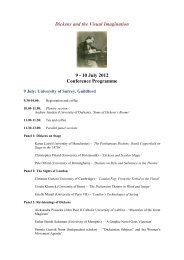The targeted killing of terrorists on foreign soil - Institute of Advanced ...
The targeted killing of terrorists on foreign soil - Institute of Advanced ...
The targeted killing of terrorists on foreign soil - Institute of Advanced ...
Create successful ePaper yourself
Turn your PDF publications into a flip-book with our unique Google optimized e-Paper software.
Tobias Ruettersh<str<strong>on</strong>g>of</str<strong>on</strong>g>f<br />
Panel 4 (a)<br />
In a sec<strong>on</strong>d step, the legitimacy <str<strong>on</strong>g>of</str<strong>on</strong>g> <str<strong>on</strong>g>targeted</str<strong>on</strong>g> <str<strong>on</strong>g>killing</str<strong>on</strong>g> is analysed, i.e. whether this method <str<strong>on</strong>g>of</str<strong>on</strong>g><br />
countering <str<strong>on</strong>g>terrorists</str<strong>on</strong>g> can be c<strong>on</strong>sidered as a just and appropriate means. Even though<br />
legitimacy is an “extremely slippery c<strong>on</strong>cept” (Hurrell 2005, 17), it can be seen from two<br />
dimensi<strong>on</strong>s. <str<strong>on</strong>g>The</str<strong>on</strong>g> first dimensi<strong>on</strong> is about process and procedure, or ‘input legitimacy’, as<br />
Fritz Scharpf (1999) labelled it. It means that an acti<strong>on</strong> or a rule is legitimate to the extent<br />
that it “has come into being and operates in accordance with generally accepted principles <str<strong>on</strong>g>of</str<strong>on</strong>g><br />
right process” (Franck 1990, 19). <str<strong>on</strong>g>The</str<strong>on</strong>g> sec<strong>on</strong>d dimensi<strong>on</strong> <str<strong>on</strong>g>of</str<strong>on</strong>g> legitimacy is c<strong>on</strong>cerned about<br />
effectiveness, what Scharpf calls ‘output legitimacy’. Similarly to the delegati<strong>on</strong> <str<strong>on</strong>g>of</str<strong>on</strong>g> authority<br />
to internati<strong>on</strong>al organisati<strong>on</strong>s or regulatory networks, which are <str<strong>on</strong>g>of</str<strong>on</strong>g>ten c<strong>on</strong>sidered legitimate<br />
to the extent to which it provides effective soluti<strong>on</strong>s (see Hurrell 2005, 22), <str<strong>on</strong>g>targeted</str<strong>on</strong>g> <str<strong>on</strong>g>killing</str<strong>on</strong>g><br />
has also to be judged by its effectiveness. In this part, I display some new and original<br />
descriptive data. In the end, all results will be summarised in the c<strong>on</strong>clusi<strong>on</strong>.<br />
My central argument is that the use <str<strong>on</strong>g>of</str<strong>on</strong>g> <str<strong>on</strong>g>targeted</str<strong>on</strong>g> <str<strong>on</strong>g>killing</str<strong>on</strong>g> is a tool <str<strong>on</strong>g>of</str<strong>on</strong>g> warfare that is highly<br />
questi<strong>on</strong>able in legal and political terms but can be legal and viable in counter-terrorism<br />
campaigns under very str<strong>on</strong>g restraints. <str<strong>on</strong>g>The</str<strong>on</strong>g> fight against terrorism across state borders has to<br />
be seen under a war paradigm. Even though the criminal behaviour <str<strong>on</strong>g>of</str<strong>on</strong>g> <str<strong>on</strong>g>terrorists</str<strong>on</strong>g> may lead<br />
politicians to invoke the law-enforcement paradigm, it is not feasible when the scale <str<strong>on</strong>g>of</str<strong>on</strong>g><br />
violence reaches a certain level that can <strong>on</strong>ly be dealt with military force or when <str<strong>on</strong>g>terrorists</str<strong>on</strong>g><br />
operate from states which are either unwilling or incapable <str<strong>on</strong>g>of</str<strong>on</strong>g> cooperating in lawenforcement<br />
(see Kretzmer 2005, 201). This means that the jus ad bellum criteria can be<br />
applied to <str<strong>on</strong>g>targeted</str<strong>on</strong>g> <str<strong>on</strong>g>killing</str<strong>on</strong>g>s. From an internati<strong>on</strong>al legal standpoint, states can invoke the<br />
right to self-defence if the <str<strong>on</strong>g>targeted</str<strong>on</strong>g> individuals are actively engaged in the planning and<br />
executi<strong>on</strong> <str<strong>on</strong>g>of</str<strong>on</strong>g> terrorist attacks against that state. From the jus in bello perspective, IHL is<br />
applicable to the fight against terrorism. It is shown that within the narrow c<strong>on</strong>fines <str<strong>on</strong>g>of</str<strong>on</strong>g> IHL,<br />
<str<strong>on</strong>g>targeted</str<strong>on</strong>g> <str<strong>on</strong>g>killing</str<strong>on</strong>g> <str<strong>on</strong>g>of</str<strong>on</strong>g> <str<strong>on</strong>g>terrorists</str<strong>on</strong>g> can be legal under certain restricti<strong>on</strong>s and circumstances.<br />
Terrorists can be c<strong>on</strong>sidered legitimate targets if they directly participate in hostilities.<br />
As menti<strong>on</strong>ed before, the questi<strong>on</strong> <str<strong>on</strong>g>of</str<strong>on</strong>g> legitimacy is certainly hard to assess. In terms <str<strong>on</strong>g>of</str<strong>on</strong>g><br />
‘input’-legitimacy, str<strong>on</strong>g arguments for and against <str<strong>on</strong>g>targeted</str<strong>on</strong>g> <str<strong>on</strong>g>killing</str<strong>on</strong>g> exist. <str<strong>on</strong>g>The</str<strong>on</strong>g>re are indeed<br />
some drawbacks to the policy <str<strong>on</strong>g>of</str<strong>on</strong>g> <str<strong>on</strong>g>targeted</str<strong>on</strong>g> <str<strong>on</strong>g>killing</str<strong>on</strong>g>, but the positive impacts <str<strong>on</strong>g>of</str<strong>on</strong>g> <str<strong>on</strong>g>targeted</str<strong>on</strong>g> <str<strong>on</strong>g>killing</str<strong>on</strong>g><br />
outweigh those negative aspects. Similarly, the ‘output-legitimacy’ <str<strong>on</strong>g>of</str<strong>on</strong>g> <str<strong>on</strong>g>targeted</str<strong>on</strong>g> <str<strong>on</strong>g>killing</str<strong>on</strong>g> is also<br />
c<strong>on</strong>tradictory. Descriptive evidence gathered by the author shows that <str<strong>on</strong>g>targeted</str<strong>on</strong>g> <str<strong>on</strong>g>killing</str<strong>on</strong>g> may<br />
be effective, particularly in Palestine. However, other empirical studies suggest that <str<strong>on</strong>g>targeted</str<strong>on</strong>g><br />
<str<strong>on</strong>g>killing</str<strong>on</strong>g> is not a significant independent variable. But those studies are flawed in the sense that<br />
they <strong>on</strong>ly look at the c<strong>on</strong>flict in Israel and <strong>on</strong>ly rely <strong>on</strong> a relatively little amount <str<strong>on</strong>g>of</str<strong>on</strong>g> data.<br />
Thus, more research is needed to prove this assumpti<strong>on</strong>.<br />
- 3 -
















